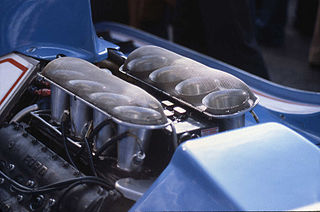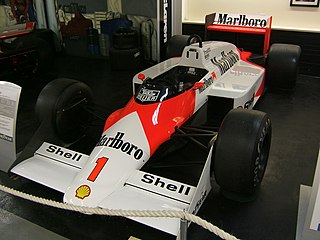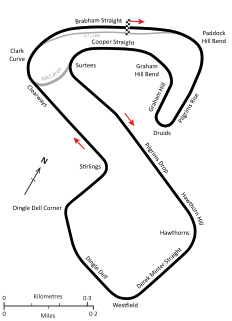
Silverstone Circuit is a motor racing circuit in England, near the Northamptonshire villages of Silverstone and Whittlebury. It is the current home of the British Grand Prix, which it first hosted as the 1948 British Grand Prix. The 1950 British Grand Prix at Silverstone was the first race in the newly created World Championship of Drivers. The race rotated between Silverstone, Aintree and Brands Hatch from 1955 to 1986, but settled permanently at the Silverstone track in 1987. The circuit also hosts the British round of the MotoGP series.

René Alexandre Arnoux is a French former racing driver who competed in 12 Formula One seasons. He participated in 165 World Championship Grands Prix winning seven of them, achieving 22 podium finishes and scoring 181 career points. His best finish in the World Drivers' Championship was third in 1983 for Ferrari. In 1977, Arnoux won the European Formula Two Championship. In 2006 he raced in the inaugural season of the Grand Prix Masters series for retired F1 drivers.

The DFV is an internal combustion engine that was originally produced by Cosworth for Formula One motor racing. The name is an abbreviation of Double Four Valve, the engine being a V8 development of the earlier four-cylinder FVA, which had four valves per cylinder.

The 1987 Japanese Grand Prix was a Formula One motor race held at Suzuka on 1 November 1987. It was the fifteenth and penultimate race of the 1987 FIA Formula One World Championship. It was the first Japanese Grand Prix since 1977, and the first as part of the Formula One World Championship to be held at the Honda-owned Suzuka Circuit, which originated as a test track for Honda motorcycles and automobiles.

The 1988 San Marino Grand Prix was a Formula One motor race held at Imola on 1 May 1988. The 60-lap race was the second round of the 1988 Formula One season. Ayrton Senna scored his first victory for the McLaren team, with turbocharged Honda-powered cars sweeping the top three positions.

The 1984 FIA Formula One World Championship was the 38th season of Fédération Internationale de l'Automobile (FIA) Formula One motor racing. Drivers and teams competed in sixteen Grands Prix for the World Drivers' and World Constructors' championship titles. The season ran from 5 March to 21 October.

Ivan Franco Capelli is an Italian former Formula One driver. He participated in 98 Grands Prix, debuting on 6 October 1985. He achieved three podiums, and scored a total of 31 championship points. From 1998 until 2017 he was a Formula One commentator on the Italian TV station Rai 1.

Stefan Nils Edwin Johansson is a Swedish racing driver who drove in Formula One for both Ferrari and McLaren, among other teams. Since leaving Formula One he has won the 1997 24 Hours of Le Mans and raced in a number of categories, including CART, various kinds of Sports car racing and Grand Prix Masters.
Motori Moderni was a Formula One engine manufacturer from 1985 through 1987. It was established by the experienced Italian engine designer Carlo Chiti.
Spirit Racing was a racing car constructor and racing team from the United Kingdom. Founded in 1981, it participated in the 1982 European Formula Two Championship, then in Formula One between 1983 and 1985, before competing in the 1988 F3000 season before finally folding at the end of the year. In 26 F1 races, its best finish was seventh at the 1983 Dutch Grand Prix.
Toleman Motorsport was a Formula One constructor based in the UK. It was active between 1981 and 1985 and participated in 70 Grands Prix.

Judd is a name brand of engines produced by Engine Developments Ltd., a company founded in 1971 by John Judd and Jack Brabham in Rugby, Warwickshire, England. Engine Developments was intended to build engines for Brabham's racing efforts, and became one of the first firms authorised by Cosworth to maintain and rebuild its DFV engines, but has since expanded into various areas of motorsport.

The Honda RA272 was a Formula One racing car designed by Yoshio Nakamura and Shoichi Sano for the 1965 Formula One season. It was the first Japanese car to win in Formula One.
Honda has participated in Formula One, as an engine manufacturer and team owner, for various periods since 1964. Honda's involvement in Formula One began with the 1964 season, and in 1965 they achieved their first victory at the Mexican Grand Prix. After further success with John Surtees, Honda withdrew at the end of the 1968 season due to difficulties selling road cars in the United States and Honda driver Jo Schlesser's fatal accident.

The McLaren MP4/4, also known as the McLaren-Honda MP4/4, is one of the most successful Formula One car designs of all time. Powered by Honda's RA168E 1.5-litre V6-turbo engine and driven by teammates Alain Prost and Ayrton Senna, the car competed during the 1988 Formula One season. It was designed by American engineer Steve Nichols, the full responsibility for the design of the chassis having been conferred on him by Ron Dennis. Gordon Murray, as Technical Director, subsequently confirmed this in an internal memo allocating responsibilities for the design department, nominating Nichols as chief designer for the car, and giving himself the role of liaising between the drawing office and production. Neil Oatley, Gordon Kimball, Pete Weismann, Tim Wright and Bob Bell also contributed towards the design of the car. Murray set parameters for Nichols and the design department that the MP4/4 had to be a low-lying car, the concept being derived from Murray's Brabham BT55, which competed 1986 season. This car, however was unsuccessful largely due to the tall height of the car's BMW straight-4 engine.

The McLaren MP4/2 was a Formula One car produced by McLaren for the 1984 season. An iteration of it, the MP4/2B, was used in the 1985 season, and a slightly updated version, the MP4/2C, raced in the 1986 season for McLaren. It was closely based on the MP4/1E model that was used as a test car, used in the final races of 1983.

The McLaren MP4/3 is a Formula One racing car built and run by McLaren International during the 1987 Formula One World Championship. It was designed under the leadership of long time McLaren engineer Steve Nichols, with engineers Neil Oatley, Gordon Kimball, Tim Wright and Bob Bell also contributing, after executive engineer John Barnard quit the team in August 1986 to join rivals Ferrari. Additionally the car was the last to be powered by a TAG-Porsche engine. It was the first all-new chassis design for McLaren International since the successful Barnard designed MP4/2 series of cars debuted at the start of the 1984 season and the first McLaren designed by anyone other than Barnard since the Gordon Coppuck designed McLaren M30 had appeared in the last three races of the 1980 season.

The 1983 Race of Champions was a non-championship Formula One race held at Brands Hatch on 10 April 1983. Contested over 40 laps, it was the final non-championship F1 race to be held in the sport's history. Reigning World Champion Keke Rosberg won in a Williams-Ford, narrowly beating the Tyrrell-Ford of F1 rookie Danny Sullivan, while 1980 World Champion Alan Jones was third in an Arrows-Ford.

The Williams FW09 was a Formula One car designed by Frank Dernie and Neil Oatley. It was the first Williams chassis to be powered by a turbocharged Honda V6 engine, for which Frank Williams negotiated a deal towards the end of 1982 and the beginning of 1983.

The Williams FW12 was a Formula One racing car used by the Williams team for the 1988 season. An updated version, the FW12C, was used for 12 of the 16 races of the 1989 season. The FW12 was Williams's first naturally aspirated car since the FW08 and FW08C used in the 1982 and 1983 season.
















